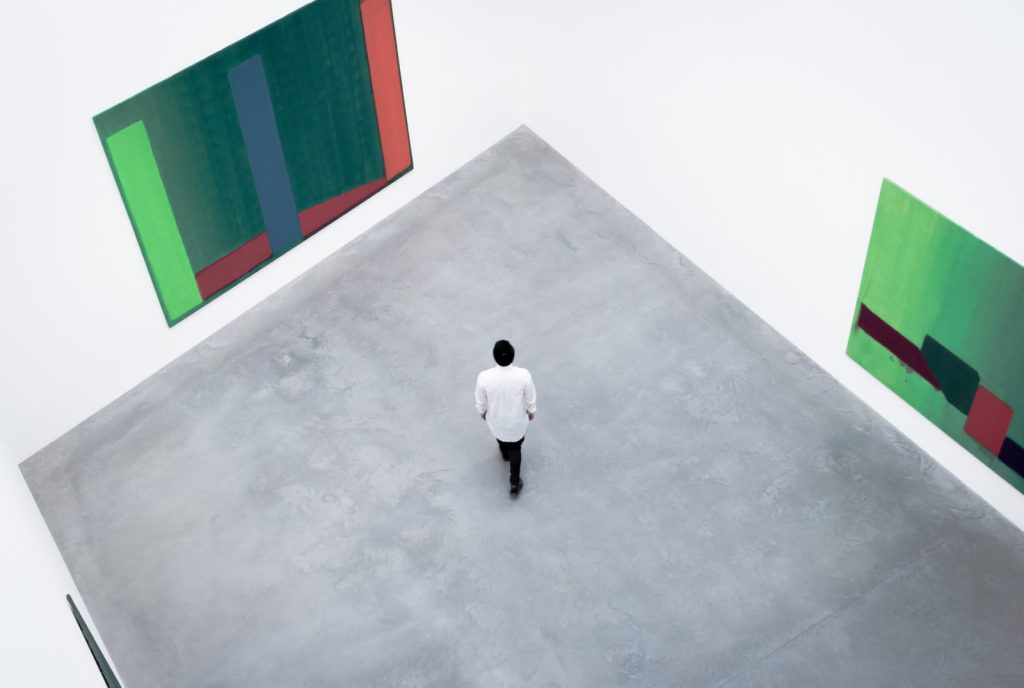
Published December 21, 2016
Claremont Review of Books - Fall 2016 issue
Robert Hughes didn’t mince words:
On the morning of February 25, 1970, Mark Rothko’s body was found in his studio in New York. He had done a thorough job of killing himself…. He lay fat and exsanguinated, clad in long underwear and black socks, in the middle of a lake of blood.
Hughes’s riveting description, black socks and all, captures both the final act of the artist’s tortured life, and the finale to the generation of New York’s pioneering abstract expressionist painters. By the time of Rothko’s suicide, Arshile Gorky, David Smith, and Jackson Pollock (the most celebrated of them all) had already shuffled off their own mortal coils. They had met their deaths, as Hughes (1938–2012) reminds us in The Spectacle of Skill, a new anthology of his writings, “by their own hand…or violent accident…or booze, old age, the usual disabilities.” It’s hard to find a more trenchant obit of an -ism than that.
* * *
The chief reason to buy The Spectacle of Skill is for Hughes’s memoir (five chapters from the first part, which appeared as Things I Didn’t Know in 2006, and eleven chapters from the unpublished second part are reprinted here), a rollicking saga of his turbulent life from his Sydney childhood to the suicide of his estranged son, Danton. Fast-paced, unbuttoned, elegant, and engrossingly written, it’s a fascinating account of its maverick author and those who came into (or left) his orbit, including many luminaries of the New York art scene. Aside from the unfinished memoir, this hefty volume features a selection of pieces from Hughes’s oeuvre, including book reviews and columns from Time magazine—the highly readable art criticism that made him famous in America. There are also long passages from his books on Rome, Barcelona, and Goya, and pages from The Fatal Shore (1986), his massively researched, brilliantly told, history of the convict settlement of Australia. Excerpts from the scripts of his TV hits, The Shock of the New (1980) and American Visions: The Epic History of Art in America (1997) are also included.
Unfortunately, readers will find themselves shortchanged. There are no illustrations of works of art, and no explanation of why these selections were published instead of others from Hughes’s work. Nor is there any information as to when and where they appeared originally, knowledge that would help put the selections in the context and chronology of the author’s life. A few simple footnotes or an editorial note in the preface would have sufficed. And, the publication of the entire memoir in a single volume would have been preferable to this retreading of random articles, some of which come from a previous anthology of Hughes’s writings and reviews.
Never mind, though, because everything here is worth reading for the first or the fifth time. The volume is a page-turner from the pen of one of the bravest, most gifted, opinionated, pugnacious, and perceptive art critics of the last 50 years. Hughes wrote with the skill of a great novelist. He had a finely tuned ear for rhythm and cadence and the gift to find just the right metaphor, analogy, or word to describe, explain, and judge what he saw. This skill is especially evident in the book’s essays on John Singer Sargent, James Whistler, and Jackson Pollock.
Much of the best writing on art comes not from academic art historians or theoretical critics, but from the pens of novelists, poets, and visual artists who creatively translate images into words. In their hands, criticism itself becomes fine art. John Ruskin, Charles Baudelaire, and Walter Pater in the 19th century, and Tom Wolfe, John Updike, and Aldous Huxley in the 20th, rose to this height. Hughes belongs in their ranks.
* * *
One of his defining attributes was nationality. Born and raised in Sydney, he came from a fairly well-to-do Australian family. His father was a lawyer with little interest in art. But if there weren’t many pictures on the walls in Hughes’s home, there was a well-stocked library. There he devoured the Romantic poets, Alice in Wonderland, and quantities of Rudyard Kipling, especially Kim and The Jungle Book. These made a lasting impression on his young mind and his future prose style. He also poured over bound volumes of Punch and the illustrations of Arthur Rackham; these were his introduction to the visual arts.
At his Catholic boarding school, where he learned Latin and lost his faith, he was fortunate to study with the headmaster, Father Wallace, who recognized his brilliance and encouraged him, as Hughes said, to read books that “probably would have featured on the [Vatican’s] Index Librorum Prohibitorem.” His mentor, much to the discomfort of the other priests, also introduced him to modernist literature, including the then-risqué writings of Ernest Hemingway, Christopher Isherwood, and James Joyce. Hughes narrowly escaped a lashing after a teacher found an anthology of Joyce that he had been reading.
Hughes went to the University of Sydney, where he wrote for the student newspaper and moved in a libertarian circle that included Germaine Greer and Clive James. After college, he was hired as a cartoonist by a local newspaper and then was abruptly made its art critic when his predecessor was fired for reviewing a show he never visited. Like a number of distinguished writers on art, including Paul Johnson and Kenneth Clark, whom Hughes admired for his art criticism if not for his social class, Hughes escaped the clutches of a Ph.D. and the constraints of jargon-laced scholarly writing and specialized research.
* * *
He grew up with a sense of the cultural inferiority of his Australian homeland. Art history and the practice of art were absent from his university’s curriculum, although Sydney’s Art Gallery of New South Wales has a collection of old masters and a good selection of Australian art (sadly, still not well enough known outside of that country). Hughes called this sense of inadequacy “the Cultural Cringe,” the assumption that what one wrote or painted or carved “is of unknown value until it is judged by people outside your own society.” This sense of “cultural colonialism,” of being an interloper, never left him. It made him feel like an outsider, both in London (where he first relocated) and New York, even at the height of his fame.
The book’s title comes from a quote that sums up Hughes’s criticism:
I am completely an elitist, in the cultural but emphatically not the social sense. I prefer the good to the bad, the articulate to the mumbling, the aesthetically developed to the merely primitive, and full to partial consciousness. I love the spectacle of skill, whether it’s an expert gardener at work, or a good carpenter chopping dovetails…. I don’t think stupid or ill-read people are as good to be with as wise and fully literate ones…. Consequently, most of the human race doesn’t matter much to me, outside the normal and necessary frame of courtesy and the obligation to respect human rights…. I am, after all, a cultural critic, and my main job is to distinguish the good from the second-rate.
This unabashed elitism in an age of egalitarianism and cultural relativity is rare and admirably politically incorrect. Hughes had zero patience with the herds of conformist, fashionable critics and art historians spouting cant about postmodern art and artists. The strength and fearlessness, and occasional eccentricity, of his judgments make The Spectacle of Skill original, iconoclastic, and bracing. Nowhere does he trim or equivocate about art, no matter what its exalted position or reputation might be.
His ideas about art changed dramatically in 1966 when the BBC sent him to cover the Florentine flood. In the Arno city, the cradle of so much European painting and sculpture, he had an epiphany:
After those days and weeks in Florence, I was never again able to join in the chorus of cultural fantasy that one heard so often in the sixties—the idea that there was something inherently repressive about old art, as though the past were a dead weight that new art, young art, had to shake off. Of course culture changes, but the idea that it simply reinvents itself, like a snake shedding its skin, is dreadfully naïve.
Art, as Hughes realized in Florence, doesn’t “foreshadow” subsequent art, but, instead, is its source, “used, imitated, learned from by later artists…it becomes part of the past and assumes the value that we associate with the past.”
* * *
This road to Damascus moment gave Hughes an understanding of just how much Western artists were indebted to their predecessors. Each succeeding generation was just the newest link in the great chain of art stretching back to Greece and Rome. For thousands of years, painters, sculptors, and architects had turned to the past for inspiration and instruction, unlike contemporary artists and critics who shun history and its values and, instead, prize a bogus “originality” above all else.
A Piero della Francesca or a Rembrandt, Hughes wrote, “is radical in a deep way that no Damien Hirst could ever be,” and to even name them “in the same sentence is faintly comical.” In his politics, Hughes was a man of the Left (his views on Ronald Reagan and conservatism are as clichéd as his art criticism is not), but when it came to art, he was a traditionalist in an age of chic conformists. Like Hilton Kramer, he refused to be bamboozled by the flimflam of the New York art market that was awash with money, greed, and strivers.
* * *
Florence was the watershed in Hughes’s criticism. It gave him a wider horizon. It enabled him to write with more perception and understanding about art. It also furnished a valuable new and wider perspective on the pretensions and humbug of many of the reigning artistic superstars of his day. Hughes was to become a devastating critic of their works, and of the dealers and critics who promoted and sold them. But art was not the only thing that he wrote about in Florence or the other cities he chronicled. He was a first-rate travel writer who captured the nuance, texture, color, and flavor of the places he visited. Intensely curious about people, places, and things, his interests ranged far beyond art and architecture to, among scores of other things, politics, history, wildlife, and the local cuisine.
One of the pleasures of The Spectacle of Skill is his amorous description of what he ate in his travels. In Florence he often dined at the venerable Buca Lapi (it’s still open) in the basement of the Palazzo Antinori. There he loved the “thick, Parmesan-clogged minestrone,” “its plump, egg-yellow pumpkin ravioli,” and the famous bistecca alla Fiorentina. In Sant’ Andrea in Percussina, a village just outside the city, he devoured “coarse bread, toasted on an open fire, rubbed with garlic, and then drenched in the local olive oil, green and thick as Castrol, densely perfumed and sprinkled with salt.” (As a graduate student living in Florence, I often ate this delicious country dish accompanied by sausages, beans, and good Chianti in the same tavern once frequented by the exiled Niccolò Machiavelli, who wrote The Prince in a villa across the street.)
* * *
Hughes’s stay in Florence is recorded in the first part of his memoirs. The second part, published in The Spectacle of Skill, is of greater historical value. It’s a richly anecdotal, gimlet-eyed telling of his life, loves, trials, and tribulations in New York where he settled in the 1970s. It’s also a fascinating story of a city that had recently become one of the international capitals of contemporary art. The memoir describes, among many other things, Hughes’s work for Time, the friendships he forged with artists (including Robert Rauschenberg, whom he called, inexplicably, “the genius of American art since the death of Pollock”), the making of his TV programs, and his life as an urban pioneer in the SoHo district before it became a high rent neighborhood.
In New York, Hughes found much art he liked and a good deal he despised, particularly that shilled by many of the reigning denizens, and false prophets, of the art world. Many of the most amusing passages in the memoir are the barbed, often sidesplitting deflations of these poobahs. About the then-fashionable artist Julian Schnabel, he opines that his “work is to painting what Stallone’s is to acting—a lurching display of oily pectorals—except that Schnabel makes bigger public claims for himself.” Commenting on a painting by the artistic duo Gilbert & George, he fails to see “how anyone can take a pair of primping narcissists like Gilbert & George seriously on any level whatsoever”; their work always struck him “as aesthetically vacuous, intellectually obvious, and complacently banal in design.” He calls Clement Greenberg, the high priest of abstract painting, “a quite limited critic, not interested in the content of works of art or their historical context, only in their formal character” and says “he had little or nothing of interest to say about any art earlier than impressionism.”
Memorializing his friend, the critic David Sylvester, Hughes says that he was a “fearlessly eccentric figure” whose prose was “sharp, aphoristic at times, free of jargon, and often beautifully judged.”
Those words are a fitting epitaph for the author of The Spectacle of Skill.
Bruce Cole is a senior fellow at the Ethics and Public Policy Center.








